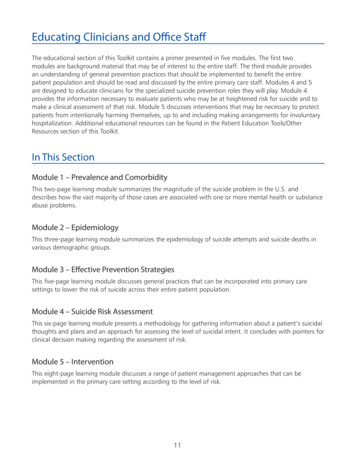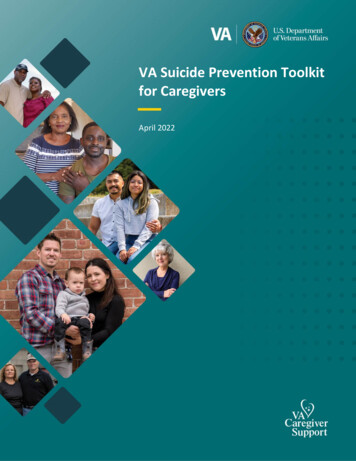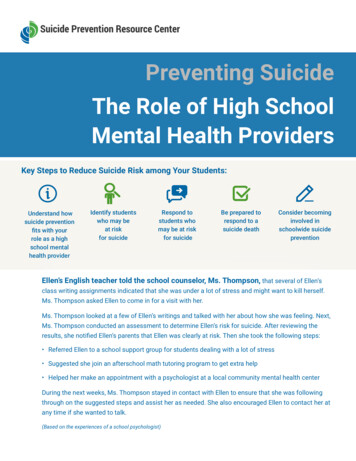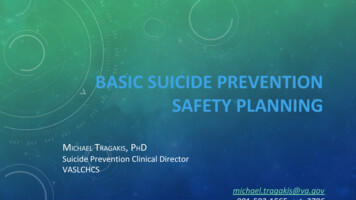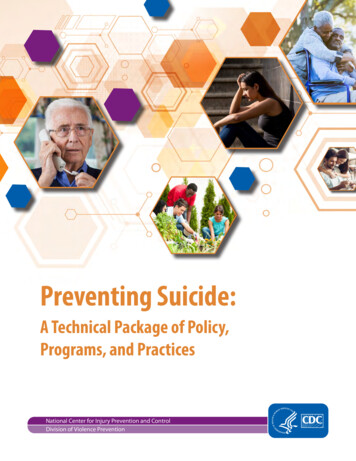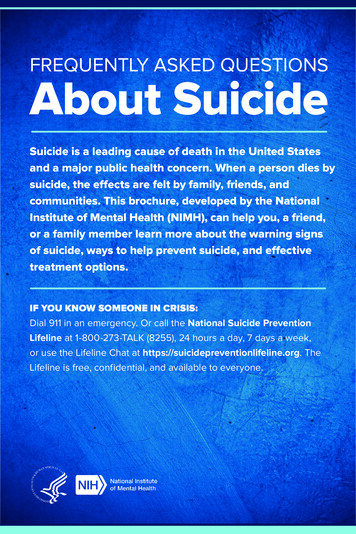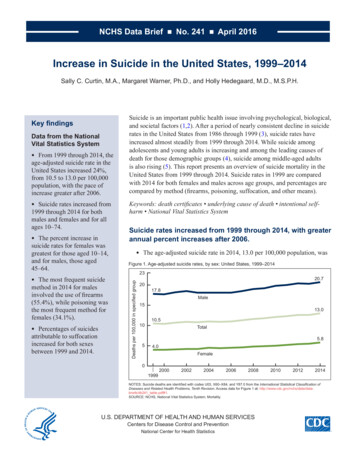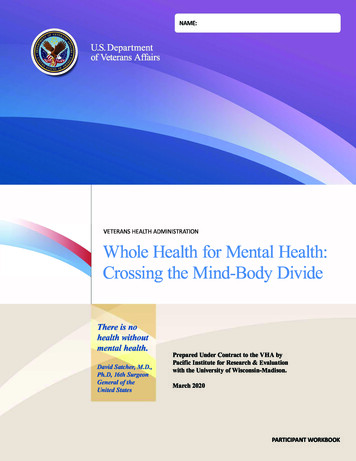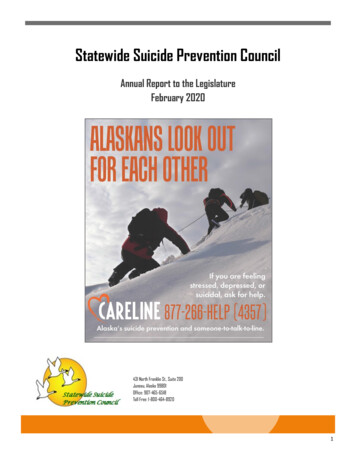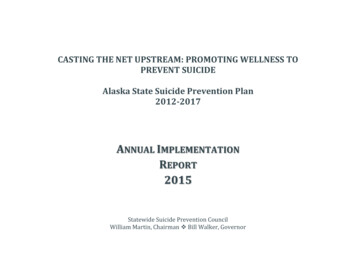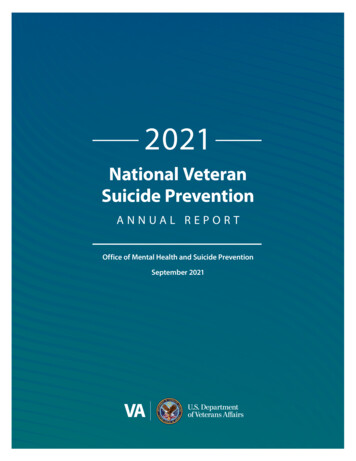
Transcription
2021National VeteranSuicide PreventionANNUAL REPORTOffice of Mental Health and Suicide PreventionSeptember 2021
Table of Contents1Introduction 3Suicide Among U.S. Adults and Among Veterans, 2001–2019 4Suicide Deaths by Count/Number 4Suicide Average Per Day 5Suicide Rates 5Summary 8Lethal Means Involved in Suicide Deaths 8COVID-19: Monitoring of VHA Suicide-Related Indicators 9Key Findings 9Select Figures 10Anchors of Hope 12Next Steps 13Suicide Prevention 2.0 (SP 2.0) 13Now Initiative 14PREVENTS 15988/Veterans Crisis Line (VCL) 15Commander John Scott Hannon Veterans Mental Health Care Improvement Act of 2019 (P.L. 116-171) 15Veterans Comprehensive Prevention, Access to Care, and Treatment Act of 2020 (P.L. 116-214) 16Veterans Benefit Administration (VBA) 16Domestic Policy Council (DPC) 16Conclusion 117The data analyses in this report are conducted by the Department of Veterans Affairs (VA) Suicide Prevention Program’s Data and Surveillance teamin the Office of Mental Health and Suicide Prevention, which includes VA staff from the Center of Excellence for Suicide Prevention and the SeriousMental Illness Treatment Resource and Evaluation Center. Suicide surveillance processes include close coordination with federal colleagues inthe Department of Defense (DoD) and the Centers for Disease Control and Prevention (CDC). This document summarizes VA suicide surveillanceprocesses, including conduct of VA/DoD searches of death certificate data from the CDC’s National Death Index (NDI), data processing, anddetermination of decedent Veteran status. A full description of the data sources for this report is available in the supplementary document located at:Veteran Suicide Surveillance: Methods Summary (va.gov).2
IntroductionThe U.S. Department of Veterans Affairs’ 2021 National Veteran Suicide Prevention Annual Report shows the overallVeteran suicide count and rate decreased in 2019 from 2018 and from 2017.The data within the report is notable because: It provides information from 2001 through 2019, while recent prior reports included data from 2005 forward. This update includes the most current data and applies methodologic enhancements, resulting in the mostcomprehensive assessment to date of Veteran suicide mortality, for the years 2001-2019.2The report represents and communicates a “whole of VA” approach to suicide prevention that integrates strategicplanning, program operations, and program evaluation across the Veterans Health Administration (VHA), the VeteransBenefits Administration (VBA), and the National Cemetery Administration. The report represents and communicatesa “whole of government” approach to suicide prevention that integrates strategic planning across federal agencies tofacilitate complementary and collaborative prevention, intervention, and postvention approaches tailored to agencyspecific populations. The report represents and communicates the value of “public/private partnerships” to reinforce andmagnify collective and unified engagement of suicide prevention.Given this background, this report includes the following updated information and data: There were 399 fewer Veteran suicides in 2019 than in 2018. There was a 7.2% overall decrease in the age- and sex-adjusted Veteran suicide mortality rate in 2019, as comparedto 2018. The unadjusted suicide rate for male Veterans decreased 3.6% in 2019 from 2018 while the unadjusted suicide ratefor female Veterans decreased 12.8% in 2019 from 2018.Decreases in Veteran suicide across multiple fronts and methods of measurement in 2019 were unprecedented across thelast 20 years.2Enhancements included improved identification of matches between VA/DoD search records and CDC NDI and assessment of mid-calendar yearVeteran population for Veteran suicide rate calculations, rather than end-of-fiscal-year population estimates.3
NATIONAL VETERAN SUICIDE PREVENTION ANNUAL REPORT SEPTEMBER 2021Suicide Among U.S. Adults and AmongVeterans, 2001–2019The number and rate of suicide deaths rose from 2001 to 2018 across the U.S. population. Yet the U.S. population, aswell as the Veteran population, experienced a decrease in the suicide count and rate from 2018 to 2019. Furthermore, inretrospect and with updated data, the Veteran suicide count decreased in 2018—one year ahead of the U.S. populationsuicide decrease, as Figures 1 and 3 illustrate. This section provides an overview of Veteran data within the context of U.S.national data organized by Suicide Deaths by Count/Number, Suicide Average Per Day, and Suicide Rates.Suicide Deaths by Count/NumberThe number (count) of suicides among U.S. adults increased from 29,580 in 2001 to 45,861 in 2019 (see Figure 1). Veteransaccounted for 5,989 suicides in 2001, which represented 20.2% of suicides among U.S. adults in 2001; and 6,261 suicidesin 2019, which, by comparison, represented 13.7% of suicides among U.S. adults in 2019. Veterans ages 55-74 were thelargest population subgroup; they accounted for 38.6% of Veteran suicide deaths in 2019.Figure 1: Suicide Deaths, by Year, 00025,00020,00015,00010,0006,2615,9895,00002001 2002 2003 2004 2005 2006 2007 2008 2009 2010 2011 2012 2013 2014 2015 2016 2017 2018 20194
NATIONAL VETERAN SUICIDE PREVENTION ANNUAL REPORT SEPTEMBER 2021Figure 2, below, provides an overview of the trend line pertaining to Veteran suicide deaths by year from 2001 to 2019.Figure 2: Veteran Suicide Deaths, 95,8005,6005,4002001 2002 2003 2004 2005 2006 2007 2008 2009 2010 2011 2012 2013 2014 2015 2016 2017 2018 2019Suicide Average Per DayThe average number of suicides per day among U.S. adults rose 55.0%, from 81.0 in 2001 to 125.6 in 2019. Across the same18-year period, the average number of Veteran suicides per day rose 4.5%, from 16.4 in 2001 to 17.2 in 2019.In 2019, among the average 17.2 Veteran suicides per day, an estimated 6.8 suicides per day were among those with VHAencounters in 2018 or 2019, whereas 10.4 per day were among Veterans with no VHA encounter in 2018 or 2019.Suicide RatesFrom 2001 to 2019, the U.S. adult population increased 26.2%, from 186.6 million in 2001 to 235.4 million in 2019. From2001 to 2019, the Veteran population decreased 23.1%, from 25.7 million in 2001 to 19.8 million in 2019. In this context,from 2001 to 2019, the unadjusted suicide rate among non-Veteran U.S. adults rose 33.0%, from 12.6 per 100,000 in 2001to 16.8 per 100,000 in 2019. In comparison, the rate among Veterans rose 35.9% from 2001 to 2019, from 23.3 per 100,000in 2001 to 31.6 per 100,000 in 2019.In 2019, the unadjusted suicide rates were highest among Veterans ages 18-34 (44.4 per 100,000). The unadjusted ratedecreased 12.8% for female Veterans in 2019 compared to 2018, and decreased 3.6% for male Veterans in 2019 comparedto 2018. To account for a) differences between the non-Veteran U.S. population and the Veteran population in termsof age and sex, and b) differences across time within the Veteran population, age- and sex-adjusted suicide rates werecalculated. Figure 3 indicates that the difference in adjusted rates between Veterans and non-Veterans was highest in2017, when Veteran adjusted rates were 66.3% greater than those for non-Veteran adults; this differential decreased to52.3% in 2019.5
NATIONAL VETERAN SUICIDE PREVENTION ANNUAL REPORT SEPTEMBER 2021Figure 3: Age- and Sex-Adjusted Suicide Rates, Veterans and Non-Veteran U.S. Adults, 2001–2019Age- and Sex-Adjusted Suicide Rate Per 100,000353025201510502001 2002 2003 2004 2005 2006 2007 2008 2009 2010 2011 2012 2013 2014 2015 2016 2017 2018 2019VeteransNon-Veteran U.S. AdultsFigure 4 demonstrates the Veteran-specific age- and sex-adjusted suicide trend rate from 2001 to 2019. The age- andsex-adjusted suicide rate decreased 7.2% in 2019 compared to 2018, decreasing from 29.0 Veteran suicides per 100,000 in2018 to 26.9 Veteran suicides per 100,000 in 2019.Figure 4: Age- and Sex-Adjusted Suicide Rates, Veterans, 2001–2019Age- and Sex-Adjusted Suicide Rate Per 100,000353025201510502001 2002 2003 2004 2005 2006 2007 2008 2009 2010 2011 2012 2013 2014 2015 2016 2017 2018 2019Veterans6
NATIONAL VETERAN SUICIDE PREVENTION ANNUAL REPORT SEPTEMBER 2021Figure 5 presents age-adjusted suicide rates for Veteran men and women by year, 2001-2019. Rates for Veteran men werehighest in 2018 (40.4/100,000) and fell 3.8% in 2019 (38.8/100,000); rates for Veteran women were highest in 2017 (19.9/100,000)and fell in 2018 (18.1/100,000) and again in 2019 (15.4/100,000), which represented a 14.9% decrease relative to 2018.Figure 5: Age-Adjusted Suicide Rate Per 100,000, Male and Female Veterans, 2001–201945Age-Adjusted Rate Per 100,00040353025201510502001 2002 2003 2004 2005 2006 2007 2008 2009 2010 2011 2012 2013 2014 2015 2016 2017 2018 2019Male VeteransFemale VeteransFigures 6 and 7 reflect the unadjusted suicide rates by race and ethnicity, respectively. White Veterans continue to exhibitthe highest unadjusted rates, followed by American Indians/Alaskan Natives; Asians, Native Hawaiians, or Other PacificIslanders; followed by Black/African American Veterans.Figure 6. Unadjusted Suicide Rates, Veterans, by Race, 2001–2019454033.6Rate Per 001 2002 2003 2004 2005 2006 2007 2008 2009 2010 2011 2012 2013 2014 2015 2016 2017 2018 2019WhiteAmerican Indian/Alaskan NativeBlack orAfrican American7Asian, Native Hawaiian,or Other Pacific Islander
NATIONAL VETERAN SUICIDE PREVENTION ANNUAL REPORT SEPTEMBER 2021Figure 7. Unadjusted Suicide Rates, Veterans, by Hispanic Ethnicity, 2001–201945403531.5Rate Per 100,00030252021.020.2151013.7502001 2002 2003 2004 2005 2006 2007 2008 2009 2010 2011 2012 2013 2014 2015 2016 2017 2018 2019HispanicNon-HispanicSummaryThere were 399 fewer Veteran suicides in 2019 than in 2018. Adjusted rates fell from 2018 to 2019 for Veterans; rates fell7.2% among Veterans and 1.8% among non-Veterans. Average Veteran suicides per day decreased to 17.2 in 2019. In 2019,the adjusted rate for Veterans was 52.3% greater than for non-Veteran U.S. adults. The rate difference between Veteransand the non-Veteran U.S. population was highest in 2017 at 66.3%.Lethal Means Involved in Suicide DeathsAmong non-Veterans overall, there were increases from 2001 to 2019 (Table 1) in the percentage of suicides involvingsuffocation and “other means” and decreases in the percentage involving firearms and poisoning. Among Veterans, therewere increases in the percentage involving firearms and suffocation and decreases for those involving poisoning andother means. Firearms accounted for 70.2% of male Veteran suicides in 2019 (up from 69.6% in 2018) and 49.8% of femaleVeteran suicides in 2019 (up from 41.1% in 2018). The proportion of firearm-related Veteran suicide deaths increased in2019 compared to 2001.Table 1: Suicide Deaths, Methods Involved, 2019 and Change From 2001*Non-VeteranU.S. %(-4.5%)Suffocation29.6%( 8.8%)8.7%( 0.6%)OtherVeterans2019Change*69.2% ( *53.0%(-5.0%)70.2%( 2.9%)31.3%(-4.2%)49.8% ( 3%16.9% ( 2.9%)30.2%( 7.9%)16.8%( 2.7%)27.7%( 12.0%)8.3%( 1.0%)5.5%(-0.8%)10.0%(-0.7%)8.4%5.4%(-0.9%)* Change Versus Among Suicide Decedents in 20018(-16.6%)20.5% ( 10.1%)3.4%(-6.3%)
NATIONAL VETERAN SUICIDE PREVENTION ANNUAL REPORT SEPTEMBER 2021COVID-19: Monitoring of VHA Suicide-RelatedIndicatorsThe sections above present information about suicide mortality through 2019, themost recent year for which cause of death information is available from the Centersfor Disease Control and Prevention (CDC). In 2020, the COVID-19 pandemic began,with tragic consequences for the people of the U.S. and around the world. Currently,there have been over four million deaths worldwide due to COVID-19,3 including over600,000 deaths in the rendsThe Secretary of Health and Human Services declared COVID-19 a national publichealth emergency on January 27, 2020. Once CDC National Death Index (NDI) data arefinalized for 2020, VA will evaluate trends in Veteran suicide related to the pandemic. Inthe context of this report, to assess trends in association with the COVID-19 pandemic,we present information on suicide-related indicators for Veterans receiving VHA care.ED DataEarlyWarningSurveillanceOn-CampusEventsPC DataHigh-RiskFlagActivityIn March 2020, VA began monitoring trends in VHA patient encounters and site-reported indicators of suicide-relatedbehavior. VHA site reports include information regarding Veteran suicide deaths and nonfatal suicide attempts.Information regarding nonfatal suicide attempts is based on VHA facility reports and diagnosis indications. We havehighlighted several examples of these in the figures below. Specifically, this work includes tracking, by week, of VHA sitereported Veteran suicides (Figure 8), VHA emergency department visits for suicide attempts (Figure 9), on-campus suicideattempts and deaths (Figure 10), and all-cause mortality among Veteran VHA patients with and without diagnosed mentalhealth conditions (Figure 11, Figure 12).Key Findings VA has not observed increases in documentation of the above suicide-related indicators. VA has observed increases in all-cause mortality among Veteran VHA patients, including those with and thosewithout diagnosed mental health conditions. Increased all-cause mortality associated with the pandemic exceedsthe number of VA deaths that have been directly attributed to COVID-19. Age- and sex-adjusted all-cause mortality is greater among Veterans in VHA care with mental health conditionscompared to other Veterans in VHA care. The level of differential mortality by mental health status has not increased since the pandemic began.3World Health Organization (2021). Weekly epidemiological update on COVID-19 – 20 July 2021. Accessed: Weekly epidemiological update onCOVID-19 - 20 July 2021 (who.int).4Centers for Disease Control and Prevention (2021) COVID-19. Accessed: ml.9
71/ /2023 19/2/ 2014 92/ /2018 19/3/ 2014 93/ /2018 19/4/ 2011 94/ /2015 194/ /2029 195/ /2013 195/ /2027 196/ /2010 196/ /2024 19/7/ 2018 97/ /2022 19/8/ 2015 98/ /2019 19/9/ 2012 99/ /2016 199/ /203 110 0/2 9/1 0110 4/2 9/2 0111 8/2 9/1 0111 1/2 9/2 015 912 /20112 /9/2 9/2 013/ 91/ 2016 91/ /2020 20/2/ 2023 02/ /2017 20/3/ 2022 03/ /2016 203/ /2030 204/ /2013 204/ /2027 205/ /2011 205/ /2025 20/6/ 2028 06/ /2022 20/7/ 2026 07/ /2020 20/8/ 2023 08/ /2017 208/ /2031 209/ /2014 209/ /202 210 8/2 0/1 0210 2/2 0/2 026 011 /20211 /9/2 0/2 023 012 /20212 /7/2 0/2 021/ 021/ 024 01/ /2018 21/2/ 2021 12/ /2015 21/3/ 2021 13/ /2015 213/ /2029 214/ /2012 214/ /2026 215/ /2010 215/ /2024 21/6/ 2027 16/ /2021 21/20211/1/71/ /2023 19/2/ 2014 92/ /2018 19/3/ 2014 93/ /2018 19/4/ 2011 94/ /2015 194/ /2029 195/ /2013 195/ /2027 196/ /2010 196/ /2024 19/7/ 2018 97/ /2022 19/8/ 2015 98/ /2019 19/9/ 2012 99/ /2016 199/ /203 110 0/2 9/1 0110 4/2 9/2 0111 8/2 9/1 0111 1/2 9/2 015 912 /20/ 112 9/2 9/2 013/ 91/ 2016 91/ /2020 20/2/ 2023 02/ /2017 20/3/ 2022 03/ /2016 203/ /2030 204/ /2013 204/ /2027 205/ /2011 205/ /2025 20/6/ 2028 06/ /2022 20/7/ 2026 07/ /2020 20/8/ 2023 08/ /2017 208/ /2031 209/ /2014 209/ /202 210 8/2 0/1 0210 2/2 0/2 026 011 /20/ 211 9/2 0/2 023 012 /20/ 212 7/2 0/2 021/ 01/ 2024 01/ /2018 21/2/ 2021 12/ /2015 21/3/ 2021 13/ /2015 213/ /2029 214/ /2012 214/ /2026 215/ /2010 21/2021Site-Reported SuicidesNATIONAL VETERAN SUICIDE PREVENTION ANNUAL REPORT SEPTEMBER 2021Select FiguresFigure 8: VHA Site-Reported Veteran Suicides, by Week4035302520151050Figure 9: VHA Emergency Department Visits for Suicide Attempts605040302010010
2015 19/1/ 20129 9/2/ 20112 9/2/ 20126 9/3/ 20112 9/3/ 20126 9/24/ 0199/4/ 20123 9/25/ 0197/5/ 20121 9/26/ 0194/6/ 20118 9/27/ 0192/7/ 20116 9/7/ 20130 9/8/ 20113 9/8/ 20127 9/9/ 20110 9/9/ 20124 9/10 201/8 910 /20/2 192/11 201/5 911 /20/1 199/12 201/3 912 /20/1 19712 /20/3 191/1/ 20114 9/1/ 20228 0/2/ 20211 0/2/ 20225 0/3/ 20210 0/3/ 20224 0/24/ 0207/4/ 20221 0/25/ 0205/5/ 20219 0/26/ 0202/6/ 20216 0/6/ 20230 0/7/ 20214 0/7/ 20228 0/8/ 20211 0/8/ 20225 0/29/ 0208/9/ 20222 0/10 202/6 010 /20/2 200/11 202/3 011 /20/1 207/12 202/1 012 /20/1 20512 /20/2 209/1/ 20212 0/1/ 20226 -ay-JuM-1r-1arApM19-1n-FebJaNumber of On-Campus Suicide ,00000On-Campus SuicidesOverall Standardized RateOn-Campus Suicide AttemptsMH Standardized Rate11Total In-Person Admit Days and Visit Days (in thousands)Figure 11: Age- and Sex-Adjusted All-Cause Mortality Per 100,000, Veteran VHA Users, by Week,Overall and by Mental Health on-MH Standardized RateOutpatient Visit Days and Inpatient Stays (in thousands)1/NATIONAL VETERAN SUICIDE PREVENTION ANNUAL REPORT SEPTEMBER 2021Figure 10: Issue Brief Indications of On-Campus Suicide Attempts and Deaths
NATIONAL VETERAN SUICIDE PREVENTION ANNUAL REPORT SEPTEMBER 2021Figure 12: Ratio of Age- and Sex-Adjusted All-Cause Mortality Per 100,000, Mental Health vs.Non-Mental Health Patients, Veteran VHA Users1.81.61.4Rate Ratio1.21.00.80.60.4The level of differential mortality by mental health statushas not increased since the pandemic began.0.212/31/21/ 017 91/ /2014 201/ /2021 201/ /2028 20/22/ 024 02/ /2011 202/ /2018 202/ /2025 20/23/ 023 03/ /2010 203/ /2017 203/ /2024 203/ /2031 20/24/ 027 04/ /2014 204/ /2021 204/ /2028 20/25/ 025 05/ /2012 205/ /2019 205/ /2026 20/26/ 022/ 026/ 029 06/ /2016 206/ /2023 206/ /2030 20/27/ 027 07/ /2014 207/ /2021 207/ /2028 20/28/ 024 08/ /2011 208/ /2018 208/ /2025 20/29/ 021/ 029/ 028 09/ /2015 209/ /2022 209/ /2029 2010 /20/ 210 6/2 0/1 0210 3/2 0/2 0210 0/2 0/2 027 011 /20/ 211 3/2 0/1 0211 0/2 0/1 0211 7/2 0/2 024 012 /20/1 2012 /20/ 212 8/2 0/1 0212 5/2 0/2 0212 2/2 0/2 029/ 021/ 025 01/ /2012 211/ /2019 211/ /2026 21/22/ 022/ 120210.0Anchors of HopeHope serves as a key and necessary anchor to strengthen Veterans amidst numerous life circumstances. In a similarmanner, hope must imbue the overall suicide prevention mission, anchoring it amidst mission challenges andcircumstances. Several hopeful data points from this year’s report serve as anchors: 399 fewer Veterans died from suicide in 2019 than in 2018, reflecting the lowest raw count of Veteran suicidessince 2007. From 2005 to 2018, identified Veteran suicides increased on average by 48 deaths each year. A reduction of 399suicides within one year is unprecedented, dating back to 2001. The single-year decrease in the adjusted suicide rate for Veterans from 2018 to 2019 (7%) was larger than anyobserved for Veterans from 2001 through 2018. Further, the Veteran rate of decrease (7.2%) exceeded by fourtimes the non-Veteran population decrease (1.8%) from 2018 to 2019. There was a nearly 13% one-year rate (unadjusted rate) decrease for female Veterans, which represents the largestrate decrease for Women Veterans in 17 years. COVID-19-related data continues to emerge and clarify, but data thus far do not indicate an increase in Veteransuicide-related behaviors. Additionally, the level of differential mortality by mental health status has not increasedsince the pandemic began.12
NATIONAL VETERAN SUICIDE PREVENTION ANNUAL REPORT SEPTEMBER 2021Next StepsAlthough VA is heartened that 399 fewer Veterans died by suicide in 2019 compared to 2018, VA is poignantly andpainfully mindful that 6,261 Veterans died by suicide in 2019. While the differential in adjusted suicide rates betweenVeterans and non-Veterans decreased from its high of being 66.3% greater in 2017, the fact remains that Veterans in 2019reflected a suicide rate 52.3% higher than non-Veterans in the U.S. The Veteran suicide rate decreased four times morein 2019 compared to the U.S. adult population in 2019, and Veterans ages 18-34 continue to die by suicide at a 1.65 timeshigher rate than other Veteran age groups, overall. Though the female Veteran suicide rate (unadjusted) decreased bynearly 13% in 2019 and the male Veteran suicide rate decreased by nearly 4%, female and male Veterans alike continue todie by firearm-related suicide at notably higher proportions than their non-Veteran peers.Although current COVID-19-related data does not indicate increased Veteran suicide behaviors, including deaths andattempts, all-cause mortality among VHA Veterans was increased during COVID-19 and exceeds the number of deathsthat have been directly associated with COVID-19. It also remains to be seen the impact of COVID-19 beyond the dataand surveillance tools and means currently available to VA. Furthermore, the potential for a negative rebound effect inthe proximal years following initial impact of wide-scale catastrophic or seismic events witnessed within modern historymerits vigilance paired with aggressive prevention and intervention preparation and implementation.Taken together, much work remains to be done. As long as Veteran suicide numbers are annually in the thousands, thereis no sense of mission accomplishment or satisfaction within VA, despite being heartened by unprecedented decreases inVeteran suicide the year prior to full COVID-19 onset. Suicide prevention, therefore, remains a top priority for VA. Beyondmere words, this level of prioritization is currently being enacted through the most significant amount of resources everappropriated and apportioned to VA suicide prevention. In response, VA continues to implement its 10-year vision, asoutlined in the 2018 National Strategy for Preventing Veteran Suicide (National Strategy),5 to end Veteran suicide throughimplementing a public health approach that combines both community-based and clinically based strategies acrossprevention, intervention, and postvention areas of focus. This strategic plan has operationalized significant deploymentand implementation of the Suicide Prevention 2.0 initiative (SP 2.0); Suicide Prevention Now initiative (Now); thePresident’s Roadmap to Empower Veterans and End a National Tragedy of Suicide (PREVENTS); 988 and Veterans CrisisLine (VCL) expansion; new legislation, including the Commander John Scott Hannon Veterans Mental Health CareImprovement Act of 2019 (Hannon Act) (P.L. 116-171) and the Veterans Comprehensive Prevention, Access to Care, andTreatment (COMPACT) Act of 2020 (P.L. 116-214); and collaborative efforts with VBA and collaborative interagency effortswith the Domestic Policy Council (DPC).Suicide Prevention 2.0 (SP 2.0)SP 2.0 includes both a Community-Based Intervention for Suicide Prevention (CBI-SP) approach and a clinical approachfocusing on broad dissemination of evidence-based psychotherapies outlined in the recently updated clinical practiceguideline.6 SP 2.0 CBI-SP reaches Veterans inside and outside of VA’s system by embracing cross-agency collaborationsand community partnerships. SP 2.0 CBI-SP migrates three initiatives into a comprehensive approach to communitybased suicide prevention addressing needs at state and local community levels: State-Based Coalition and CollaborationBuilding Model (e.g., Governor’s Challenge, Veterans Integrated Service Network (VISN)-Based Community Coalition andCollaboration Building Model (e.g., VISN-wide community suicide prevention pilot programs) and Veteran-to-VeteranCoalition Building Model (e.g., Together With Veterans). For state-level prevention, VA, along with the Substance Abuseand Mental Health Service Administration (SAMHSA), is expanding the Governor’s Challenges to Prevent Suicide Among5Department of Veterans Affairs (2018). National Strategy for Preventing Veteran Suicide. Washington, DC. Available at https://www.mentalhealth.va.gov/suicide rans-Suicide.pdf.6Department of Veterans Affairs and Department of Defense (2019). VA/DoD clinical practice guideline for the assessment and management ofpatients at risk for suicide. Accessed: /VADoDSuicideRiskFullCPGFinal5088212019.pdf.13
NATIONAL VETERAN SUICIDE PREVENTION ANNUAL REPORT SEPTEMBER 2021Service Members, Veterans, and their Families. Through these efforts, VA, SAMHSA, and state-level policy makers partnerwith local leaders to implement a comprehensive suicide prevention plan. Currently, 35 states are actively engaged witha goal to reach all 50 states by the end of 2022. For local community action through interstate efforts, VA is expandingcommunity-based efforts across all VISNs with the Community Engagement and Partnerships – Suicide Prevention programfocused on community coalition-building combined with targeted outreach and education. VA has expanded to nineVISNs and will engage the remaining nine VISNs by the end of 2022. Finally, VA is expanding community-based effortsthrough rural Veteran-to-Veteran approaches through the Together With Veterans program, partnering with VA’s Officeof Rural Health program to focus on building partnerships with rural Veterans and their communities to implementcommunity-based suicide prevention. Five evidence-based strategies support local planning efforts. These strategies aredesigned for community-wide implementation to increase awareness and knowledge about Veteran suicide and improvecommunity response to the needs of local Veterans. Across all three approaches to CBI-SP, there are three overarchingfocused priority areas: 1) identifying Service members, Veterans, and their families and screening for suicide risk; 2)promoting connectedness and improving care transitions; and 3) increasing lethal means safety and safety planning.SP 2.0 clinical efforts are focused on increased access to evidence-based psychotherapies for suicide prevention asoutlined by the Clinical Practice Guidelines (CPG): Cognitive Behavioral Therapy for Suicide Prevention, Problem-SolvingTherapy, and Dialectical Behavioral Therapy, as well as Advanced Safety Planning Interventions. To that end, VA’s SuicidePrevention Program has partnered with VA’s national Clinical Resource Hub leadership team to stand up nationaltelehealth capability to provide these treatments outlined in the CPG. VA is currently hiring over 100 clinicians to providethese treatments across all 140 health care systems. In addition to both SP 2.0 community and clinical efforts, the SP 2.0model is built upon a foundation of mental health and suicide prevention staffing to ensure Veterans have access to thefull continuum of mental health services. The minimal outpatient mental health staffing ratio includes 7.72 outpatientmental health full-time employee equivalent (FTEE) staff per 1,000 Veterans in outpatient mental health and a nationalminimum benchmark for suicide prevention staffing at 0.1 suicide prevention coordinators/case manager FTEE per 1,000Veterans enrolled at a facility. Currently, our suicide prevention staffing models are being revised to help best informstaffing needs with expansion of suicide prevention efforts in VA.Now InitiativeThe Now initiative aims to initiate quick deployment of interventions that are deemed to most efficiently impact Veteransat high risk for suicide within one year. The five areas of focus are: 1) lethal means safety; 2) suicide prevention in medicalpopulations; 3) outreach to and understanding of prior VHA users; 4) suicide prevention program enhancements (e.g.,Recovery Engagement and Coordination for Health – Veterans Enhanced Treatment (REACH-VET) expansion, SafetyPlanning in the Emergency Department expansion); and 5) paid media. Over the past year, several advancements havebeen accomplished through Now, including mandatory training requirements of all VHA providers in lethal means safety,expanded partnerships with the National Shooting Sports Foundation and American Foundation for Suicide Preventionfor publishing a lethal means safety toolkit, piloting efforts to re-engage prior VHA users, reaching all five REACH-VETperformance metrics nationally, increased safety planning in the emergency department from a baseline of 35% to 86%,and significant expansion of paid media campaigns.14
NATIONAL VETERAN SUICIDE PREVENTION ANNUAL REPORT SEPTEMBER 2021PREVENTSOn March 5, 2019, Executive Order 13861 was signed and established a three-year effort known as PREVENTS.The Roadmap developed by the PREVENTS Office, co-chaired by White House DPC Director and the Secretary ofVeterans Affairs, has three main areas of focus: National Suicide Prevention Campaign, improving suicide preventionresearch, and building partnerships. Recently, PREVENTS came under the oversight of VA’s Office of Mental Health andSuicide Prevention. PREVENTS efforts have been coordinated and cross-walked nationally to ensure amplification ofa unified public health approach in alignment with the National Strategy and its operationalized plans in SP 2.0 andNow initiatives.988/Veterans Crisis Line (VCL)VCL provides 24/7 world-class crisis services through phone, chat, and text for all Veterans, Service members, NationalGuard and Reserve members, and their family members and friends. The recent enactment of the National SuicideHotline Designation Act (P.L. 116-172) established 988 as a national three-digit emergency telephone number, replacingthe full 1-800-273-8255 National Suicide Prevention Lifeline number. This full transition must occur by July 16, 2022.Forecasting modeling projects that transitioning to a three-digit code will increase VCL call volume significantly, and VCLis implementing plans to meet this increased demand. Pres
4 NATIONA VETERAN SUICID PREVENTION ANNUA REPOR SEPTEMBE 2021 Suicide Among U.S. Adults and Among Veterans, 2001-2019 The number and rate of suicide deaths rose from 2001 to 2018 across the U.S. population.
